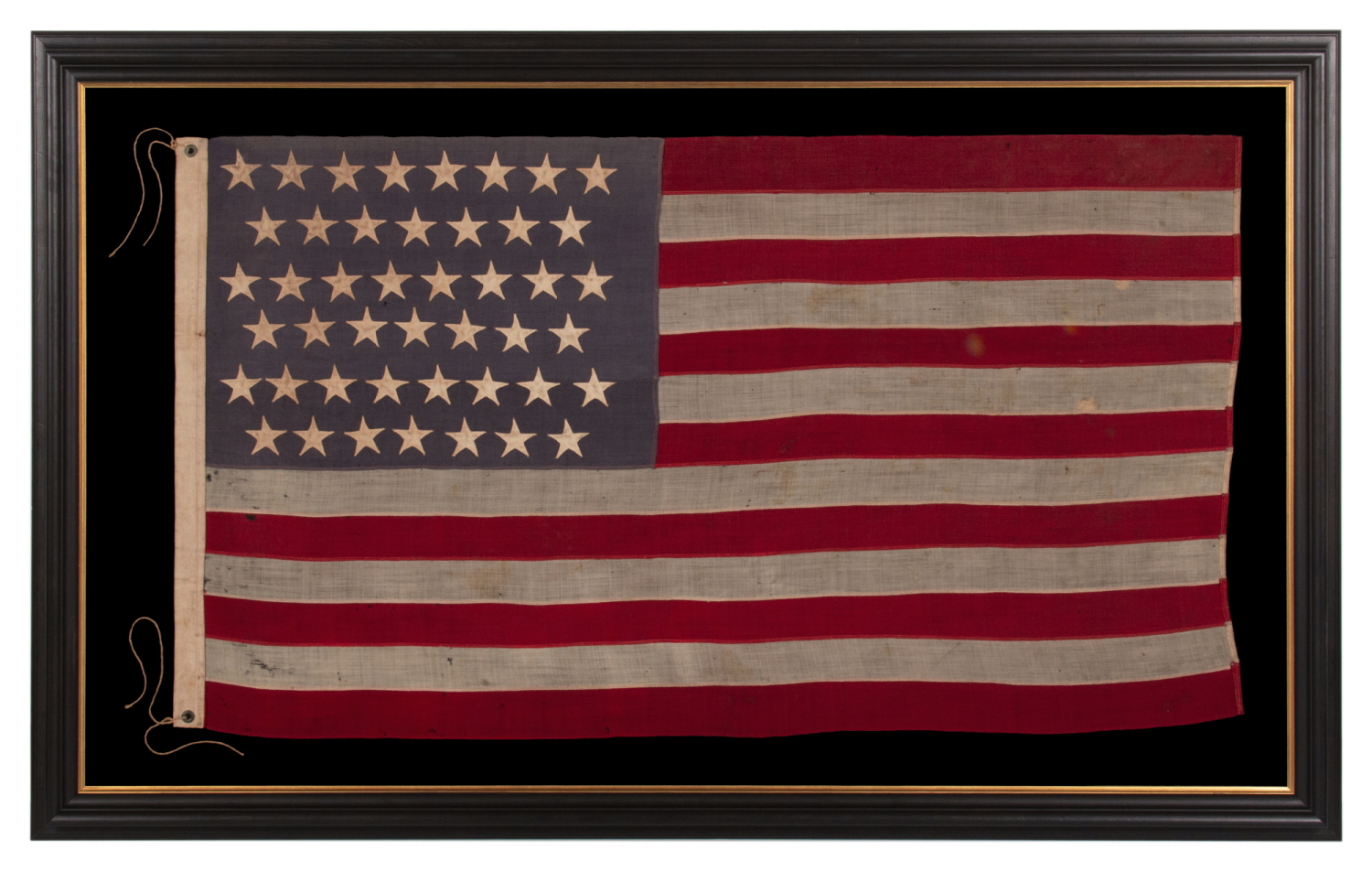
| |
45 STAR ANTIQUE AMERICAN FLAG WITH STAGGERED ROWS OF STARS ON A DUSTY BLUE CANTON; REFLECTS THE PERIOD WHEN UTAH WAS THE MOST RECENT STATE TO JOIN THE UNION, 1896-1908 |
|
| Available: |
Sold |
| Frame Size (H x L): |
44.75" x 72.25" |
| Flag Size (H x L): |
33.25" x 58.5" |
|
| Description....: |
|
Utah became the 45th state in 1896. It had been attempting to gain statehood for many years, but remained a territory, primarily due to the fact that the Mormon Church and Utah authorities continued to be openly tolerant of polygamy. In 1890, Mormon Church President Wilford Woodruff published a manifesto that denounced the contract of “any marriages forbidden by the law of the land”. This gave way to Utah’s 1896 acceptance.
Although this technically remained the official star count until July 3rd, 1908, the 45 star flag was generally used from that year until 1907, when Oklahoma joined the Union. Due to the Spanish-American War (1898) and Teddy Roosevelt’s famous world tour of the “White Fleet” (launched in 1907), this was an extremely patriotic period.
The stars of this particular example are configured in staggered rows of 8-7-8-7-8-7, a typical formation on 45 star examples. The stars are made of cotton and are all oriented with one point upward. These were expertly double-appliquéd (applied to both sides) with a lineal, treadle stitch. The striped field and canton are made of wool bunting that has been pieced and joined with the same stitching. Note how the canton has faded to a dusty blue-grey. Some of the blue wool bunting acquired by flag-makers near the opening of the last decade of the 19th century, and sometimes encountered shortly thereafter, was produced with a fugitive dye, fading whether or not it was exposed to light. The result is actually more interesting than one might expect, generally adding rather than detracting to a flag’s overall appearance, while at the same time lending a trait that assists in both the translation and authentication of its age.
There is a canvas sailcloth binding along the hoist, with two brass grommets. Note the blue filament woven into this fabric, which aided in the visual determination of lengths of this material as it came off the bolt. Also note the hemp or jute ties along the hoist end, used to affix it to a staff. These add a particularly nice visual feature to the presentation.
While the scale may seem large to a casual observer, unfamiliar with 19th century examples, it is important to understand that most flags with pieced-and-sewn construction, made prior to 1890, measured 7-8 feet larger on the fly. At just a hair under 3 x 5 feet, this is a relatively small flag among its counterparts.
Mounting: The flag was mounted and framed within our own conservation department, which is led by expert staff. We take great care in the mounting and preservation of flags and have framed thousands of examples.
The black-painted, hand-gilded and distressed molding is Italian. The background is 100% cotton twill, black in color, that has been washed and treated for colorfastness. The glazing is U.V. protective acrylic (Plexiglas). Feel free to contact us for more details.
Condition: In addition to the fading of the blue, detailed above, there is very minor soiling and staining throughout. There is a darning repair near the fly end of the 3rd white stripe. There is very minor mothing throughout, most significant beneath the canton, near the hoist. Many of my clients prefer early flags to show their age and history of use. |
|
|
|
| Collector Level: |
Intermediate-Level Collectors and Special Gifts |
|
| Flag Type: |
Sewn flag |
|
| Star Count: |
45 |
|
| Earliest Date of Origin: |
1896 |
|
| Latest Date of Origin: |
1907 |
|
| State/Affiliation: |
Utah |
|
| War Association: |
1898 Spanish American War |
|
| Price: |
SOLD |
|
| |
Views: 939 |
|
|
|

